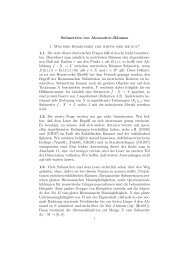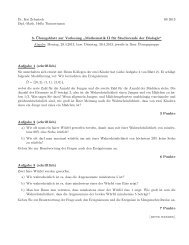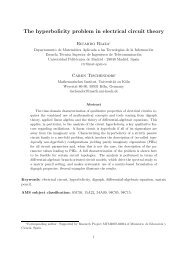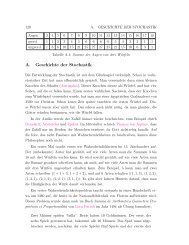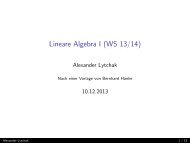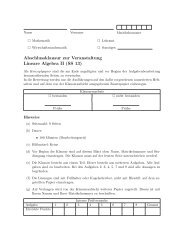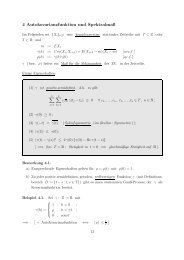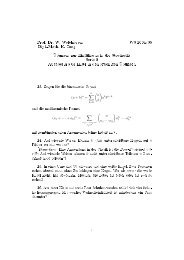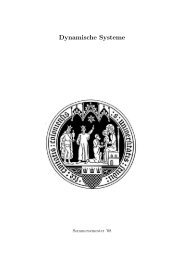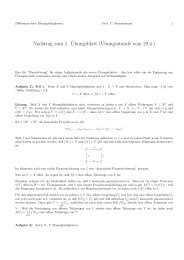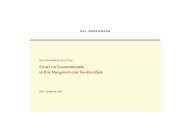Inhaltsverzeichnis - Mathematisches Institut der Universität zu Köln
Inhaltsverzeichnis - Mathematisches Institut der Universität zu Köln
Inhaltsverzeichnis - Mathematisches Institut der Universität zu Köln
Create successful ePaper yourself
Turn your PDF publications into a flip-book with our unique Google optimized e-Paper software.
Markus Richter<br />
Karlsruher <strong>Institut</strong> für Technologie (KIT)<br />
Optimierung photonischer Bandstrukturen<br />
DMV Tagung 2011 - <strong>Köln</strong>, 19. - 22. September<br />
Unter einem photonischen Kristall versteht man einen Nichtleiter, dessen Materialstruktur eine räumliche<br />
Periodizität aufweist. Die Periodenlängen betragen dabei typischerweise nur wenige Hun<strong>der</strong>t Nanometer.<br />
Durch ein geeignetes mathematisches Modell für die Lichtausbreitung in periodischen Medien, kann<br />
jedem photonischen Kristall eine so genannte photonische Bandstruktur <strong>zu</strong>geordnet werden. Aus einer<br />
solchen Bandstruktur lassen sich bestimmte optische Eigenschaften des photonischen Kristalls ablesen.<br />
Für technische Anwendungen ist es vorteilhaft, bestimmte Kenngrößen <strong>der</strong> Bandstruktur <strong>zu</strong> maximieren.<br />
Da die Bandstruktur letztlich eine Funktion <strong>der</strong> Materialstruktur eines photonischen Kristalls ist, kann man<br />
ein solches Problem als Form- o<strong>der</strong> Topologieoptimierungsproblem formulieren. Der Vortrag stellt das <strong>zu</strong>grunde<br />
liegende mathematische Modell sowie einige numerische Algorithmen vor, mit denen Probleme<br />
<strong>der</strong> Bandstrukturoptimierung gelöst werden können.<br />
Literatur<br />
Richter, M. (2010). Optimization of Photonic Band Structures. Dissertation Fakultät für Mathematik, Karlsruher<br />
<strong>Institut</strong> für Technologie.<br />
Guido Schnei<strong>der</strong><br />
<strong>Universität</strong> Stuttgart<br />
The mKdV equation as a model for short pulses<br />
We consi<strong>der</strong> a lattice model for the evolution of electro magnetic waves in homogeneous and periodic<br />
media. With a multiple scaling ansatz a mKdV equation can be <strong>der</strong>ived. We prove an approximation<br />
theorem showing that solutions of the original system behave as predicted by the modulation equation.<br />
Our approach allows the description of short and ultra short light pulses.<br />
Christian Wieners<br />
Karlsruhe <strong>Institut</strong> für Technologie<br />
Parallel computation of photonic band gaps<br />
We investigate photonic crystals, modeled by a spectral problem for Maxwell’s equations with periodic<br />
electric permittivity. By Floquet-Bloch theory, the spectrum has band-gap structure, and the bands are<br />
characterized by families of eigenvalue problems on a periodicity cell, depending on a parameter k varying<br />
in the Brillouin zone K. The numerical approximation of a band gap requires the accurate computation<br />
of several eigenvalues for sufficiently many parameters k. We introduce a parallel multgrid method for<br />
Maxwell’s equations discretized with suitable modified finite elements in or<strong>der</strong> to handle the quasi-periodic<br />
boundary conditions (depending on the parameter k which introduces a complex shift along periodically<br />
identified boundaries). This is used as a preconditioner in the iterative eigenvalue solver LOBPC. Here, it<br />
is required to modify the LOBPC method by including a projection onto the divergence free vector fields<br />
in every iteration step. Again, this projection is realized by a parallel multigrid method. We demonstrate<br />
the efficiency of this method by several examples.<br />
109




